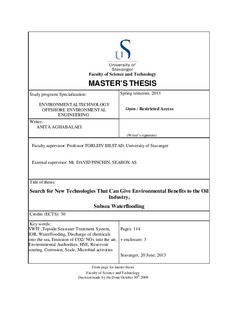Search for new technologies that can give environmental benefits to the oil industry, subsea waterflooding
Master thesis
Permanent lenke
http://hdl.handle.net/11250/182602Utgivelsesdato
2013Metadata
Vis full innførselSamlinger
Sammendrag
The goal of the oil producing companies are to extract hydrocarbon from the reservoir and make it available to customers. From an environmental perspective, it should be achieved with zero accidents, no harm to people, no impact on animal life cycle and no damage to the environment. The oil industry and environmental authorities are working closely together to achieve this by seeking practices and technologies that can support them reducing emissions, discharges and to be energy efficient.
Oil production from a reservoir general happens in three phases such as primary recovery, secondary recovery and tertiary recovery. In primary oil recovery, oil is produced to the surface by natural reservoir pressure. The oil production rate reduces when the reservoir pressure gradually decreases.
Secondary recovery (Increased Oil Recovery) usually involves large scale operational techniques such as Water Injection (WI) or Water and Gas (WAG) Injection. Injection of large volumes are introduced as an alternative to make up the pressure decline in an oil reservoir. Water and gas is injected into the reservoir to pressurise and sweep as much oil as possible to the production wells.
Tertiary oil recovery (Enhanced Oil Recovery) generally happens towards the end of field lifetime and is more field specific. Techniques can include Polymer Injection, CO2 injection, Low salinity water injection, etc. and are not usually designed for at platform design stage. It should be mentioned that tertiary recovery method is not as a scope of this paper although some tertiary methods are dependent on good secondary recovery practices.
Beskrivelse
Master's thesis in Environmental technology
